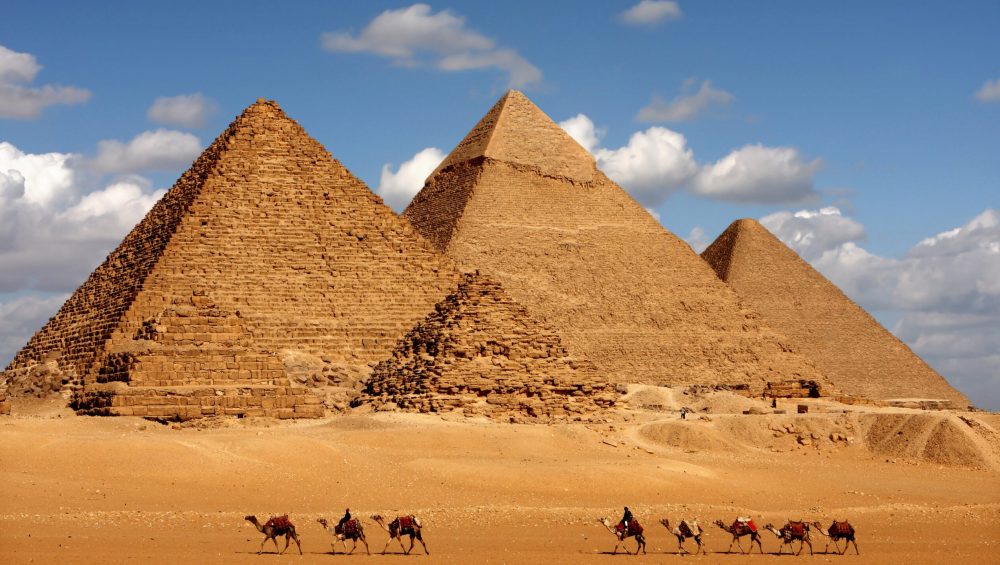The Marvel of Egyptian Pyramids: A Journey Through Time
An Iconic Legacy: The Egyptian Pyramids
The Egyptian pyramids stand as one of humanity’s most remarkable architectural achievements. These ancient structures, built thousands of years ago, continue to captivate and inspire people worldwide. From the towering Great Pyramid of Giza to the smaller, lesser-known pyramids scattered across Egypt, these monuments are a testament to the ingenuity, ambition, and cultural significance of Ancient Egypt.
What Makes the Egyptian Pyramids So Unique?
The pyramids’ unique design, astronomical alignment, and historical importance make them unparalleled in the ancient world. They were not only royal tombs but also symbols of power and a bridge to the afterlife for Egypt’s pharaohs.
Experience the land of pharaohs with our all-inclusive Egypt tours
The Great Pyramid of Giza: A Wonder of the Ancient World
The Oldest and Only Surviving Wonder
The Great Pyramid of Giza, built for Pharaoh Khufu around 2580–2560 BCE, is the largest and most famous pyramid. At 146.6 meters tall, it held the title of the tallest man-made structure for over 3,800 years. This UNESCO World Heritage Site continues to amaze with its precise construction and alignment with the cardinal points.
How Was It Built?
One of history’s greatest mysteries is how the Ancient Egyptians built the Great Pyramid. Scholars theorize that it involved tens of thousands of skilled laborers, advanced engineering techniques, and simple yet effective tools like ramps and sledges. Recent discoveries even suggest the use of intricate waterways to transport the massive limestone blocks.
Inside the Pyramid
Visitors can explore the Great Pyramid’s narrow corridors and chambers, including the King’s Chamber, Queen’s Chamber, and the Grand Gallery. Each room holds clues to ancient Egyptian burial practices and beliefs about the afterlife.
Beyond Giza: Lesser-Known Pyramids of Egypt
The Pyramid of Djoser: The Step Pyramid
Located in Saqqara, the Pyramid of Djoser is considered the earliest colossal stone structure. Built during the 27th century BCE for Pharaoh Djoser, its stepped design marked a groundbreaking shift from traditional mudbrick mastabas to monumental stone architecture.
The Bent Pyramid
Located in Dahshur, this pyramid’s unusual angled sides give it a unique appearance. Built for Pharaoh Sneferu, the Bent Pyramid provides valuable insights into the evolution of pyramid construction.
The Red Pyramid
Also built by Sneferu, the Red Pyramid is Egypt’s first true smooth-sided pyramid. Its reddish hue, caused by the limestone used in construction, sets it apart from others in the region.
Why Were the Pyramids Built?
Pyramids served as elaborate tombs for pharaohs and a demonstration of their divine authority. Ancient Egyptians believed that the pyramid’s shape symbolized the sun’s rays, helping the deceased ascend to the heavens.
The Religious Significance
Pyramids were more than burial sites; they were sacred monuments tied to Egyptian cosmology. Many align with celestial events, emphasizing the connection between the pharaohs and the gods.
Tips for Visiting the Pyramids
Best Time to Visit
The ideal time to visit Egypt’s pyramids is between October and April, when the weather is cooler. Early mornings and late afternoons offer the best light for photography and fewer crowds.
What to Bring
- Comfortable Shoes: Exploring pyramid complexes involves walking across uneven terrain.
- Sun Protection: Hats, sunscreen, and plenty of water are essential in the desert climate.
- Camera: Don’t miss the opportunity to capture these wonders from every angle.
Entry Fees and Accessibility
Tickets are required to access pyramid sites, with additional fees for entering specific pyramids like the Great Pyramid of Giza. Some pyramids may have limited accessibility due to narrow passages and steep inclines.
Fun Facts About the Egyptian Pyramids
- Precise Alignment: The Great Pyramid is aligned within 0.05 degrees of true north.
- Hidden Chambers: Recent advancements in technology have revealed previously unknown voids inside the Great Pyramid.
- Labor Force: Contrary to popular belief, pyramids were built by skilled laborers, not slaves. These workers lived in nearby villages and were well-fed and cared for.
Why the Egyptian Pyramids Matter Today
Cultural Significance
The pyramids are more than historical monuments; they are cultural icons that have inspired countless works of art, literature, and architecture. They symbolize human creativity and ambition.
Modern Research
From robotic exploration to ground-penetrating radar, modern technology continues to unlock the secrets of the pyramids. Ongoing research sheds light on construction techniques, the daily lives of workers, and the pyramids’ role in ancient Egyptian society.
Explore the Egyptian Pyramids: A Bucket List Experience
How to Plan Your Trip
- Start in Cairo: The Pyramids of Giza are just a short drive from the Egyptian capital. Begin your journey here to see the most iconic sites.
- Visit Saqqara and Dahshur: These sites offer a deeper understanding of the evolution of pyramid construction.
- Take a Guided Tour: An experienced guide can provide valuable insights into the history and significance of each site.
Embrace the Adventure
From camel rides around the pyramids to watching the Sound and Light Show at Giza, there are countless ways to enhance your visit. Each experience brings the history and mystique of the pyramids to life.
Conclusion: A Timeless Journey
The Egyptian pyramids are more than ancient wonders; they are a bridge to a civilization that shaped human history. Whether you’re marveling at the grandeur of the Great Pyramid, exploring the innovative designs of Saqqara, or uncovering hidden gems in Dahshur, a journey to the pyramids is an unforgettable adventure.
Ready to Discover the Pyramids?
Don’t wait to experience the magic and mystery of Ancient Egypt. Book your trip to Egypt today and step into a world where history, architecture, and legend converge.




